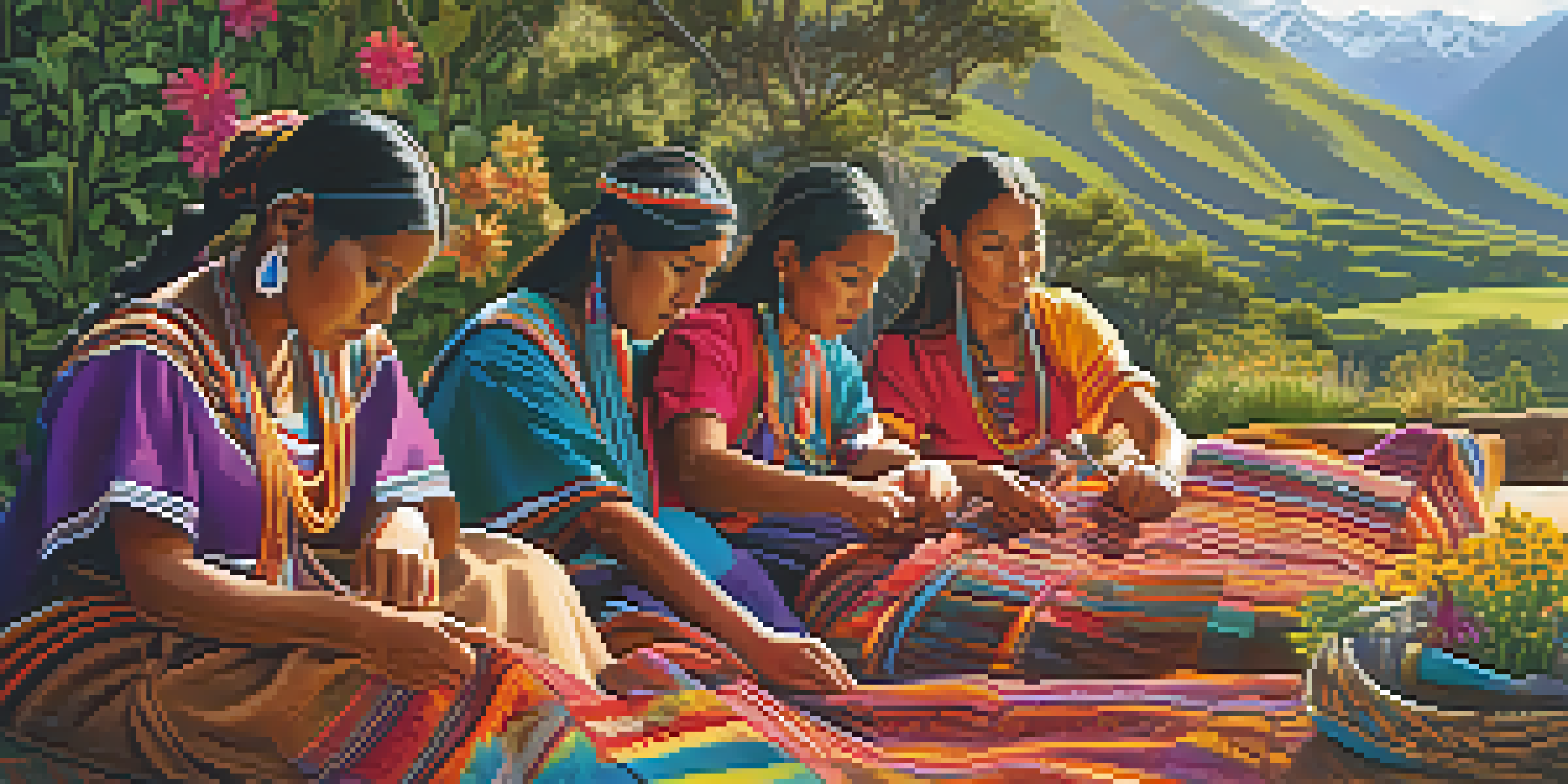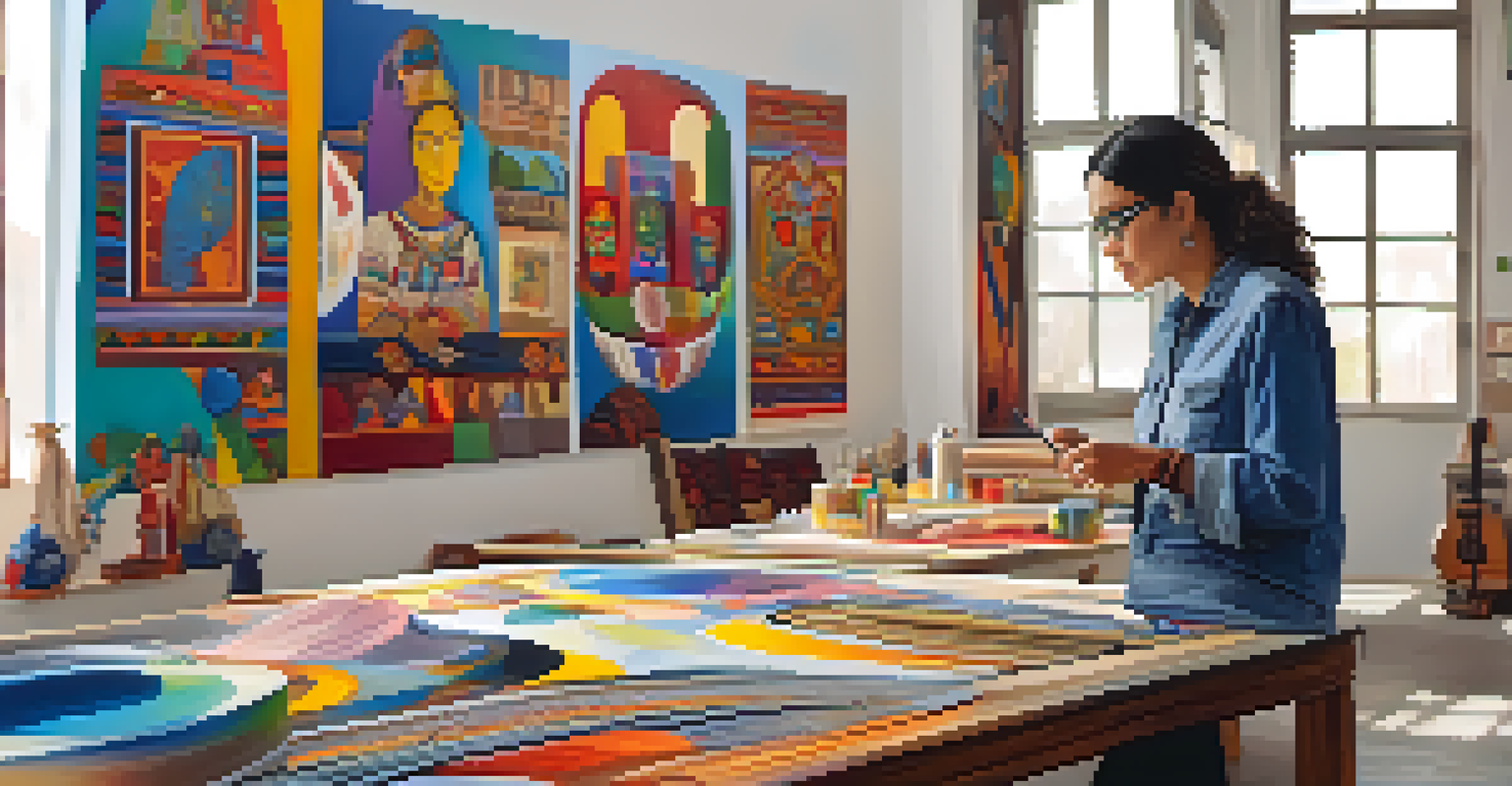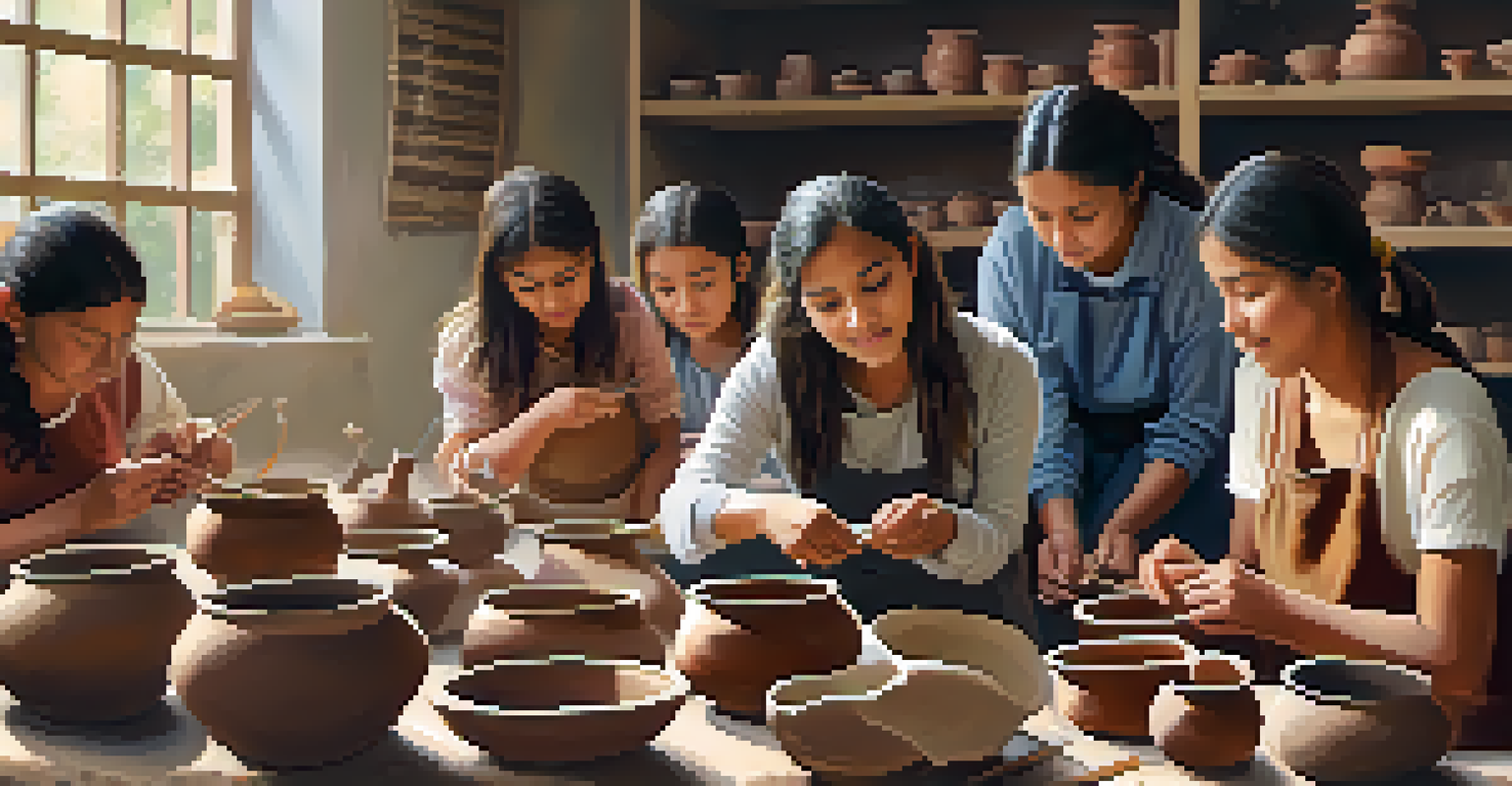The Role of Women in Peruvian Art: Past and Present

Historical Context of Women in Peruvian Art
In the tapestry of Peruvian art, women have played a vital but often overlooked role. Historically, many female artists were confined to domestic spaces, yet they expressed their creativity through textiles, pottery, and folk art. These forms of expression were not just hobbies; they were essential to cultural identity and community storytelling. As we look back, it's clear that these early contributions laid the groundwork for future generations of women artists.
Art is not a mirror held up to reality but a hammer with which to shape it.
The colonial period saw women artists begin to emerge, albeit under the shadow of male dominance in the art world. However, their work often reflected the fusion of indigenous and European influences, showcasing a unique perspective that was distinctly their own. Artists like Rosa Cordero in the 19th century began to gain recognition, challenging the norms of their time and paving the way for others. Their tenacity and creativity sparked a slow but steady evolution in the perception of women in art.
By the 20th century, the landscape began to shift more dramatically. Women such as Teresa Burga and Julia Codesido became prominent figures, using their art to challenge social and political issues. This era marked the beginning of a broader acceptance of female artists, as they began to receive the recognition they deserved. The historical context of women in Peruvian art reveals a rich legacy that continues to inspire today.
The Influence of Indigenous Women in Art
Indigenous women have been instrumental in preserving and promoting Peruvian artistic traditions. Their skills in weaving, ceramics, and traditional crafts have not only sustained cultural practices but have also transformed them into forms of artistic expression. For example, the intricate textiles from the Andean regions tell stories of their communities, blending artistry with cultural heritage. This connection to their roots is a powerful testament to their role in the art world.

The art created by indigenous women often serves as a means of resistance against colonial and patriarchal structures. Through their work, they assert their identities and challenge the narratives imposed upon them. Women like the artisans from Cusco have used their crafts to reclaim their history and heritage, making their voices heard in a predominantly male-dominated landscape. Their artistry becomes a form of empowerment, allowing them to redefine their roles within society.
Women's Historical Impact in Art
Women in Peru have historically contributed significantly to art, often through textiles and crafts, which laid the foundation for future generations.
Today, the influence of indigenous women is celebrated and recognized more than ever. Initiatives that promote their work not only support local economies but also ensure that these art forms continue to thrive. The vibrant colors and patterns in their textiles carry stories from generations past, reminding us of the importance of preserving such cultural legacies. Their contributions to Peruvian art are invaluable, enriching the national narrative.
Contemporary Women Artists Making Waves
In recent years, contemporary women artists in Peru have gained international acclaim, pushing boundaries and redefining artistic norms. Artists like Elham Tazhibi and Claudia Coca are using innovative techniques and mediums to address pressing social issues such as gender equality and environmental concerns. Their work often serves as a critique of societal norms, sparking conversations and inspiring change. This new wave of artists showcases the evolving role of women in the art scene today.
Creativity takes courage.
These contemporary artists are not just creating art for art's sake; they are using their platforms to advocate for marginalized voices. Through installations, multimedia projects, and exhibitions, they tackle themes of identity, feminism, and cultural heritage. For example, Coca's work often incorporates traditional Peruvian motifs while addressing modern-day challenges, bridging the gap between the past and present. This fusion of old and new reflects the dynamic nature of Peruvian art.
Moreover, the rise of digital platforms has enabled these artists to reach broader audiences, transcending geographical boundaries. Social media has become a vital tool for networking and sharing their work, allowing them to connect with global movements. As a result, contemporary Peruvian women artists are not only influencing the local art scene but are also making significant contributions to the international art community.
Art as a Medium for Social Change
Art has always been a powerful tool for social change, and Peruvian women artists are harnessing this power to address critical issues. Many use their creativity to comment on societal injustices, gender inequality, and environmental degradation. Through their work, they challenge viewers to reflect on these issues and consider their impact on society. This approach transforms art into a medium for activism, where each piece carries a message that resonates beyond the canvas.
For instance, artists like Teresa Burga have created installations that critique consumerism and its effects on cultural identity. By using their art to highlight these themes, they engage audiences in meaningful conversations about the world around them. This engagement encourages a sense of responsibility and awareness, empowering individuals to take action. The role of women in using art for social change is not just revolutionary; it's essential in today's world.
Indigenous Women Preserve Heritage
Indigenous women artists play a crucial role in maintaining and transforming Peruvian artistic traditions, using their work as a form of cultural expression and resistance.
Furthermore, these artists often collaborate with other activists and organizations to amplify their messages. By uniting their efforts, they create a stronger platform for advocacy. Their ability to blend artistic expression with activism makes their work impactful, fostering a sense of community and solidarity. In this way, women in Peruvian art play a crucial role in shaping the discourse around important social issues.
Challenges Faced by Women Artists
Despite the progress made, women artists in Peru continue to face significant challenges. Gender bias and inequality remain prevalent, often limiting opportunities for recognition and funding. Many female artists report feeling marginalized in spaces traditionally dominated by men. This struggle for visibility is an ongoing battle, one that requires constant effort and advocacy for change.
Additionally, societal expectations can create barriers for women pursuing careers in the arts. Family responsibilities and cultural norms often place additional pressures on female artists, making it difficult for them to dedicate time to their craft. The challenge of balancing personal and professional life is a recurring theme that affects many women in the field. This dual struggle underscores the need for supportive systems that empower women in their artistic endeavors.
However, a growing awareness of these challenges has led to initiatives aimed at supporting women artists. Organizations and collectives are emerging to provide resources, mentorship, and platforms for female voices. By fostering a sense of community and collaboration, these efforts are helping to break down barriers. While challenges persist, the resilience and determination of women artists in Peru continue to shine through.
The Role of Education in Empowering Women Artists
Education plays a crucial role in empowering women artists in Peru, offering them the skills and knowledge needed to thrive in the art world. Art schools and workshops specifically designed for women are popping up, providing safe spaces for creative expression. These educational initiatives not only teach technical skills but also foster confidence and a sense of community among participants. The impact of education on women in art cannot be underestimated; it opens doors to new opportunities.
Moreover, educational programs often emphasize the importance of cultural heritage and identity. By incorporating traditional techniques and themes, these programs help women artists connect with their roots while exploring contemporary issues. This blend of past and present enriches their artistic practice, allowing them to create meaningful work that resonates with broader audiences. Education thus becomes a vital tool for self-discovery and empowerment.
Contemporary Artists Drive Change
Modern Peruvian women artists are gaining international recognition as they use their art to address social issues, advocate for marginalized voices, and inspire community engagement.
In addition, mentorship programs are increasingly becoming available, connecting emerging artists with established figures in the industry. These relationships provide invaluable guidance and support, helping women navigate the complexities of the art world. As more women gain access to education and mentorship, the landscape for female artists in Peru continues to evolve, paving the way for future generations.
The Future of Women in Peruvian Art
As we look ahead, the future of women in Peruvian art appears vibrant and promising. The ongoing efforts to promote gender equality and support female artists are gradually transforming the art landscape. With more platforms dedicated to showcasing women’s work, we can expect to see an increase in visibility and recognition for their contributions. This positive shift is crucial for inspiring the next generation of female artists.
Moreover, the integration of technology into the art world presents new opportunities for women to express themselves and reach wider audiences. Digital art, online galleries, and virtual exhibitions allow artists to transcend physical limitations, making their work accessible globally. This evolution is particularly significant for women artists, as it provides them with tools to share their narratives and connect with diverse audiences.

Ultimately, the legacy of women in Peruvian art is one of resilience and creativity. As they continue to break barriers and challenge conventions, their influence will undoubtedly shape the future of the art world. With every brushstroke and every creation, women artists are redefining what it means to be an artist in Peru, ensuring that their voices are heard and celebrated for years to come.